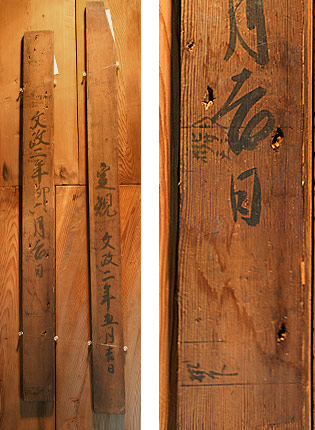|
||
 |
||

Nagatomi
永富 house owning (Hyougo)
(C)2001 Japanese Architecture and Art Net Users System. No reproduction or republication without written permission.
掲載のテキスト・写真・イラストなど、全てのコンテンツの無断複製・転載を禁じます。
|
||||||
| jougi 定規 | ||||||
| KEY WORD : architecture / tools | ||||||
| A gauge used to confirm the straightness of structural
members. A structural member is placed between the two boards of the gauge and
then rubbed. If there is no space between the gauge and the member then the member
is straight. The gauge is made of a pair of straight-grained Japanese cypress,
hinoki 桧, boards which are about 60-90cm long, about 6cm wide and have
a maximum thickness of 10mm. One example of its use is the centering of a long
wooden member like a beam or log. The gauge is placed at each end of the log,
and the log is thoroughly checked for any distortion. The portion with the least
distortion is located, and used to center the log using a carpenter's ink pad
*sumitsubo 墨壷. The jougi
is also used to ascertain the flatness of the finished material as well. |
||||||
 Nagatomi
永富 house owning (Hyougo)
|
||||||
| REFERENCES: | ||||||
| EXTERNAL LINKS: | ||||||
| NOTES: | ||||||
(C)2001 Japanese Architecture and Art Net Users System. No reproduction or republication without written permission. 掲載のテキスト・写真・イラストなど、全てのコンテンツの無断複製・転載を禁じます。 |
||||||